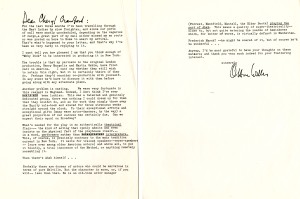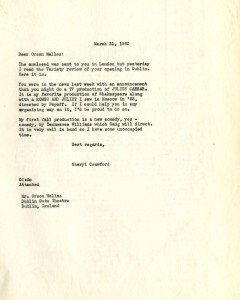
Finding Aid for the Cynthia Macdonald Papers Now Available Online
What does it mean to live the Writer’s Life? We often hold to the stereotype of the solitary writer, alone among her books in a cramped apartment above a laundromat or a Greek restaurant, hammering away at the keyboard (or better yet: typewriter) to the strains of the city outside her window, the cacophony of sirens and taxicabs and nightclub jazz and the whistle and scream of anguished souls on the streets below. Or the even more hermit-like author, tucked away in a mountain cabin, sitting in a rocking chair he carved himself while ruminating on the beautiful mysteries of Mother Nature and the folly of humankind.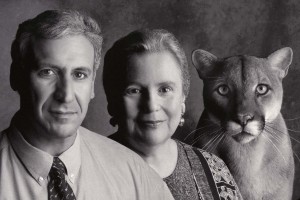
But there is another way, and Cynthia Macdonald, co-founder of the UH Creative Writing Program, has lived it. The Writer’s Life can be one that is fully engaged with the world around her. The writer can laugh and cry and struggle and celebrate with an unrelenting vigor. The writer can draw people into her orbit; can follow her curiosity down myriad paths to become an eclectic expert; can live firmly on the ground in the real world and turn its drudgeries and heartbreaks and ecstasies into Art.
The finding aid for the Cynthia Macdonald Papers is now available online, and the collection is a treasure trove for researchers, writing students, fans of Macdonald’s poetry, and anyone interested in seeing how a writer makes a go of it in this world.
Special Collections houses more than 45 boxes of Cynthia Macdonald’s work and personal materials. The collection includes multiple drafts of her 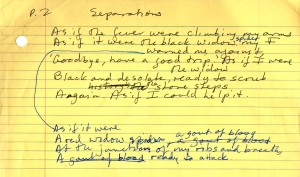 poems, both published and unpublished, both typed and handwritten, from scrawls on paper napkins and backs of envelopes to fully polished manuscripts. In addition to Macdonald’s writings, the collection also highlights the business and publicity surrounding a modern writer: contracts and royalty statements; writing proposals, grants, and awards; news clippings, book reviews, and poetry readings.
poems, both published and unpublished, both typed and handwritten, from scrawls on paper napkins and backs of envelopes to fully polished manuscripts. In addition to Macdonald’s writings, the collection also highlights the business and publicity surrounding a modern writer: contracts and royalty statements; writing proposals, grants, and awards; news clippings, book reviews, and poetry readings.
The abundance of correspondence is especially rich, featuring letters to and from Macdonald’s writing friends, teaching colleagues, and family members. Among the many noteworthy contributors are famous poets and writers such as Louise Erdrich, James Michener, Adrienne Rich, and Anne Sexton, as well as artists in other fields such as painter Helen Frankenthaler, photographer Gay Block, and singer Judy Collins.
The collection also provides a window into Macdonald’s long career as co-founder and teacher at UH’s acclaimed Creative Writing Program; her early, budding career as an opera singer; and her later, successful career as a professional psychoanalyst. The diligent researcher can also piece together other aspects of Macdonald’s life from a vast array of personal and family mementos and photographs, collected over almost the entire course of her life, from early childhood onward.
For more information about what is contained in the collection, be sure to take a look at the detailed finding aid. The original materials can be viewed in the Special Collections Reading Room.
So, what does it mean to live the Writer’s Life – or any life, for that matter? One way is to hunker down, hole up, and protect one’s writing and one’s heart in the safety of one’s own company, alone, but safe, but alone. Another way, though, as Cynthia Macdonald has demonstrated, is to reach out for all of life, to embrace life fiercely and expressly, to share bravely our thoughts and opinions and hearts with others, to write and live and write again and live some more, to dare to engage every aspect of the world around us, opening ourselves to the possibility of pain, yes, but to that of love as well.
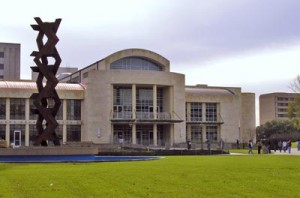 It’s been a busy few months here in Special Collections. While many Houstonians flocked to beaches and waterparks, researchers beat the heat by spending long hours in our air-conditioned Reading Room. Our team of Librarians and Archivists, meanwhile, buckled down to make more collections available and to update our offerings.
It’s been a busy few months here in Special Collections. While many Houstonians flocked to beaches and waterparks, researchers beat the heat by spending long hours in our air-conditioned Reading Room. Our team of Librarians and Archivists, meanwhile, buckled down to make more collections available and to update our offerings.
Archival Collections:
A couple of the new finding aids worth checking out are the Houston Hip Hop Recording Artists Collection and the UH Women’s Resource Center Records. And collections incorporating new material into revised finding aids include the Women in the Visual and Literary Arts Records and the Houston Area Women’s Center Photographs.
Website:
The Special Collections website has also undergone a facelift this summer, with new pages highlighting some of our collecting areas: Architecture & Planning; Contemporary Literature; Hispanic Collections; Houston & Texas History; Performing Arts; and University Archives.
Comings and Goings:
We wished farewell this summer to Alison Clemens, our Houston and Texas History Archives Fellow who took a permanent position at Yale University’s Beinecke Rare Book & Manuscript Library. This week, we welcome our new Houston Arts & History Archives Fellow, Stacey Lavender, who comes to us from the University of Michigan.
General Info:
Remember, here in Special Collections we have a number of tools to help with your classwork or research. We collect, preserve, and make available archives, rare books, and other great materials of cultural and historical significance. So if you need to use primary sources, be sure to check us out.
Our summer hours (Mon-Fri, 9am-5pm) continue through September 6. On September 7, we’ll start our fall hours, which means we’ll also be open most Saturdays from 12n-4pm. If you plan to visit our Reading Room and aren’t sure when we’re open, you can always check out our hours online.
Welcome back to school, Coogs!
As noted recently on NPR, today marks the 125th anniversary of the publication of the classic baseball poem, “Casey at the Bat,” in 1888. One of our patrons heard the piece on the radio, and while visiting us in the Reading Room for some other research, asked if we might happen to have any materials related to this poem. A discussion ensued, and while we do not have any direct connection, a challenge was thrown down: Could we find a connection from “Casey at the Bat” to something in our archives in six steps, a la “Six Degrees of Separation”?
Well, here we go:
1. “Casey at the Bat” was written by Ernest Thayer.
2. Ernest Thayer was friends with William Randolph Hearst from their days together at the Harvard Lampoon – and Hearst later hired Thayer as humor columnist for the San Francisco Examiner, which first published “Casey” in 1888.
3. William Randolph Hearst was the inspiration for the renowned film Citizen Kane, directed by and starring Orson Welles.
4. Orson Welles exchanged correspondence with theater producer/director Cheryl Crawford; this correspondence is available right here in our archives among the Cheryl Crawford Papers.
Six degrees? Ha! We got there in four. So although there might be “no joy in Mudville,” as “mighty Casey has struck out,” we are feeling a bit victorious here in Special Collections today.
Interested researchers and visitors may view these letters and much more in our Reading Room. The bulk of the Cheryl Crawford Papers dates from 1940-1978, documenting Ms. Crawford’s career in theater through correspondence, production materials, scripts, programs, playbills, audio tapes, posters, sheet music, sound recordings, clippings, budgets, tax returns, legal agreements, contracts, audits, reviews, speeches, and miscellaneous items such as postcards and receipts.
Do you watch Mad Men? A lot of us here in Special Collections do, and we noticed that on last night’s episode (no spoilers here, we promise) the book that Don Draper is reading on the airplane is Larry McMurtry’s The Last Picture Show. Not only do we have in our stacks a copy of that exact edition in Draper’s hands (a first printing of the Dell paperback from 1967),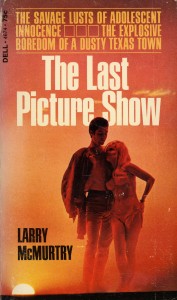 but we also have in our archives Larry McMurtry’s first draft of the typescript of the novel, complete with handwritten notes, a character list, an outline, and some discarded pages. Researchers and fans of McMurtry’s work can visit us here to follow the evolution of this novel from first draft to second draft to publisher’s copy, and compare these to the final published piece. (We highly recommend the 1971 film version of the book as well, available in the Anderson library’s DVD collection.)
but we also have in our archives Larry McMurtry’s first draft of the typescript of the novel, complete with handwritten notes, a character list, an outline, and some discarded pages. Researchers and fans of McMurtry’s work can visit us here to follow the evolution of this novel from first draft to second draft to publisher’s copy, and compare these to the final published piece. (We highly recommend the 1971 film version of the book as well, available in the Anderson library’s DVD collection.)
So, what does it mean for Don Draper to be reading The Last Picture Show? Well, we have some ideas, but don’t want to give away any spoilers in case you haven’t watched the episode yet.
 Student library assistant Thuan Vu from Special Collections has been awarded a prestigious Hamill Library Scholarship! This merit-based scholarship is awarded to library student assistants in good standing, who exhibit leadership qualities, and who are full time students with a minimum GPA of 3.0.
Student library assistant Thuan Vu from Special Collections has been awarded a prestigious Hamill Library Scholarship! This merit-based scholarship is awarded to library student assistants in good standing, who exhibit leadership qualities, and who are full time students with a minimum GPA of 3.0.
Thuan, a senior majoring in Electrical Engineering at UH, has worked in Special Collections for almost three years. In addition to being the “face” of the department by working at the reception desk and greeting patrons, Thuan also retrieves and shelves rare books and archival materials; assists in processing collections; makes archival book covers; enters metadata; performs general office duties such as filing and copying; and handles anything else thrown his way.
Thuan is a member of the National Society of Collegiate Scholars, and also volunteers for Project C.U.R.E., troubleshooting and repairing medical equipment that will be donated to developing countries around the world.
Congratulations, Thuan!
